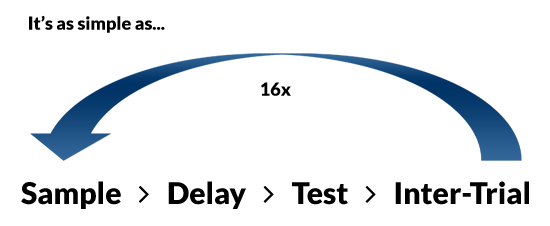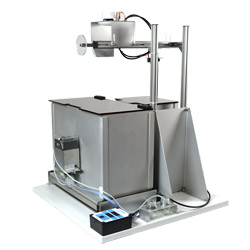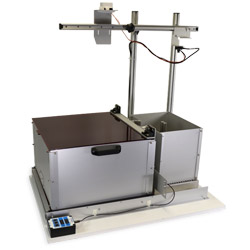"Continual Trials" Methodology
In "Continual Trials" methodology, the animal moves between home-cage and experimental chamber under its own natural motivation, but with a temporal control of the four periods of each trial, with each trial repeated for 16 to 20 times per session. Statistical power is maintained with animal usage reduced by up to 60%.

The Modular "Build-as-you-go" System
Diagram of the stages of our modular system (PDF)
With support from NC3Rs and UK Innovate, these chambers have been developed specifically for Easton's novel methodology of "Continual Trials" NOR, OL and OPC.
The traditional rectangular shape of the experiment or object chamber is retained and can be mounted on either a regular floor or a sliding floor to provide a context change for OPC (or termed "what-where-which" tasks, for episodic-like memory in rodents).
The chamber design is modular and open, starting with a "build-your own" basic chamber and manual gate, to which can be added a camera (triggered by the gate microswitch) for the bespoke video scoring app - simply connect via available USB port.
Five further stages of modularity give the following options:
- PC control, I/O, and autogate with photobeams
- Pellet or liquid feed and trough to train and motivate shuttling (not as reward for object choice)
- Multiple chambers
- OPC/WWW sliding context change floors
- Sliding gantry (with fully opening gate) for tethered optogenetics or electrophysiology
Scoring
The video scoring app is essential for capturing all the data from the 16-20 trials in each session and enables review of the object scoring and other behavioral parameters that may be indicative of anxieties and such as latencies from gate to object.
Once downloaded, a spreadsheet gives bouts and times of exploration of the novel and familiar objects, for easy calculation of the Discrimination Ratio.
Current Research
Work has already included rats for up to 700g and Alzheimer's TASTPM mice for example. Sensitivity to pro-active interference and other new windows into mechanisms have been shown. The ability to collect significantly more data per day has advantages in developmental work and also with short-life compounds.
Easton's "Continual Trials" is also being used with human children, moving between two small spaces and a battery of objects in the same methodology.
Key Publications
- Ennaceur & Delacour 1988 (Object preference)
- Ennaceur & Meliani 1992 (Memory for location)
- Ennaceur & Aggleton 1997 (Prh lesions in spatial and NOR)
- Dix & Aggleton 1999 (Object-location)
- Dix & Aggleton 1999 (Object-context)
- Easton, Eacott, Zinkivskay 2005; Eacott & Norman 2004 (Combinations, Episodic memory)
- Eacott & Gaffan 2005; Easton & Eacott 2010 (Variety of different memories, dissociation of underlying mechanisms)
- Varghese, Brett, Harland, Van-Nobelen & John Dalrymple-Alford, 2009 Episodic memory, odour context
- Davies, Easton, Eacott, Gigg 2013 Episodic memory for WWW & Episodic memory & Alzheimer's-like pathology
Continual Trials NOR & OL
- Ameen-Ali, Easton & Eacott 2012 (rats)
- Ameen-Ali et al 2015 (improved reliability & interpretation)
- Seel, Eacott, Langston & Easton 2017 (rats)
Continual Trials 2018-2019 Papers
- Chan, M, Austen, J. M., Eacott, M. J., Easton, A. & Sanderson, D. J. (2019). The NMDA receptor antagonist MK-801 fails to impair long-term recognition memory in mice when the state-dependency of memory is controlled. Neurobiology of Learning and Memory 161: 57-62. - Abstract
- Cholinergic input to the hippocampus is not required for a model of episodic memory in the rat, even with multiple consecutive events. Behavioural Brain Research, Volume 354, Pages 48-54 15 November 2018, S. V. Seel, M. J. Eacott, R. F. Langston, A. Easton Behavioural Brain Research 354: 48-54. - Abstract
- Continual Trials Spontaneous Recognition Tasks in Mice: Reducing Animal Numbers and Improving Our Understanding of the Mechanisms Underlying Memory. Frontiers In Behavioural Neuroscience 13 September 2018, Chan, Eacott, Sanderson, Wang, Sun & Easton Frontiers in Behavioral Neuroscience 12: 214. - Abstract
Related papers on Recognition and Episodic Memory
- Pereda, D., Al-Osta, I., Okorocha, A.E., Easton, A. & Hartell, N.A. (2019). Changes in presynaptic calcium signalling accompany age-related deficits in hippocampal LTP and cognitive impairment. Aging Cell 18(5): e13008. - Abstract
- Incidental context information increases recollection. Learning & Memory 24(3): 136-139. - Abstract
- Ameen-Ali, K.E., Easton, A. & Eacott, M.J. (2015). Moving beyond standard procedures to assess spontaneous recognition memory. Neuroscience and Biobehavioral Reviews 53: 37-51. - Abstract
- Robertson, B-A., Eacott, M.J. & Easton, A. (2015). Putting Memory in Context: Dissociating memories by distinguishing the nature of context. Behavioural Brain Research 285: 99-104. - Abstract
- Davis, KE, Easton, A., Eacott, MJ & Gigg, J (2013). Episodic-Like Memory for What-Where-Which Occasion is Selectively Impaired in the 3xTgAD Mouse Model of Alzheimer's Disease. Journal of Alzheimer's Disease 33(3): 681-698. - Abstract
- Davis, K.E., Eacott, M.J., Easton, A & Gigg, J. (2013). Episodic-like memory is sensitive to both Alzheimer's-like pathological accumulation and normal ageing processes in mice. Behavioural Brain Research 254: 73-82. - Abstract
- Ameen-Ali,K.E., Eacott,M.J. & Easton,A. (2012). A new behavioural apparatus to reduce animal numbers in multiple types of spontaneous object recognition paradigms in rats. Journal of neuroscience methods 211(1): 66-76. - Abstract
- Easton, A & Eacott, MJ (2012). Cholinergic mechanisms of episodic memory: what specific behavioural tasks can tell us about specific neural mechanisms. Brain Research Bulletin. - Abstract
- Easton, A, Webster, LAD & Eacott, MJ (2012). The episodic nature of episodic-like memories. Learning & Memory 19(4): 146-150. - Abstract
- Easton, A., Child, S. & Lopez-Crespo, G. (2011). Differential outcomes aid the formation of categorical relationships between stimuli. Behavioural Brain Research 222(1): 270-273. - Abstract
- Easton, A., Fitchett, A., Eacott, M.J. & Baxter, M.G. (2011). Medial septal cholinergic neurons are necessary for context-place memory but not episodic-like memory. Hippocampus 21(9): 1021-1027. - Abstract
- Eacott, MJ & Easton, A (2010). Episodic memory in animals: Remembering which occasion. Neuropsychologia 48(8): 2273-2280. - Abstract


